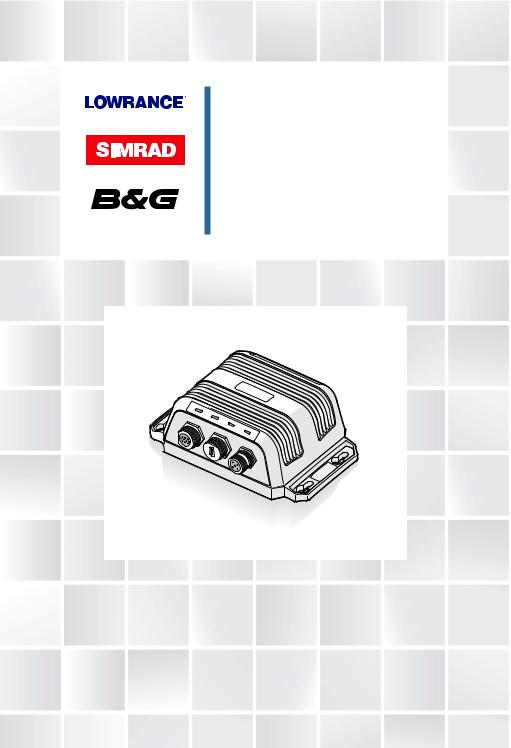B&G NAIS-400 User Manual

NAIS-400 Class B
AISTransceiver
User Manual
ENGLISH
www.bandg.com | www.simrad-yachting.com | www.lowrance.com

Preface
As Navico is continuously improving this product, we retain the right to make changes to the product at any time which may not be reflected in this version of the manual. Please contact your nearest distributor if you require any further assistance.
It is the owner’s sole responsibility to install and use the NAIS-400 AIS Class B Transceiver in a manner that will not cause accidents, personal injury or property damage. The user of this product is solely responsible for observing safe boating practices.
NAVICO HOLDING AS AND ITS SUBSIDIARIES, BRANCHES AND AFFILIATES DISCLAIM ALL LIABILITY FOR ANY USE OF THIS PRODUCT IN A WAY THAT MAY CAUSE ACCIDENTS, DAMAGE OR THAT MAY VIOLATE THE LAW.
Governing Language: This statement, any instruction manuals, user guides and other information relating to the product (Documentation) may be translated to, or has been translated from, another language (Translation). In the event of any conflict between any Translation of the Documentation, the English language version will be the official version of the Documentation.
This manual represents the product as at the time of printing. Navico Holding AS and its subsidiaries, branches and affiliates reserve the right to make changes to specifications without notice.
Copyright
Copyright © 2012 Navico Holding AS.
Warranty
The warranty card is supplied as a separate document.
About this manual
Important text that requires special attention from the reader is emphasized as follows:
¼¼ Note: Used to draw the reader’s attention to a comment or some important information.
 Warning: Used when it is necessary to warn personnel that they should proceed carefully to prevent risk of injury and/or damage to equipment/personnel.
Warning: Used when it is necessary to warn personnel that they should proceed carefully to prevent risk of injury and/or damage to equipment/personnel.
Preface | NAIS-400 User Manual |
| 1 |

Contents
4 Notices
4 Safety warnings
4 General notices
8About your AIS class B transceiver
8About AIS
9Static and dynamic vessel data
9Important information for US customers
10What’s in the box?
13 Installation
13 Preparing for installation
15 Installation procedures
23 Configuring your AIS transceiver
23Switching on your AIS transceiver for the first time
24Configuring your AIS transceiver
24 Introduction to proAIS2
26 Operation
26 Using the AIS transceiver
26 Switch functions
26 Using proAIS2 with your AIS transceiver
26 Indicator functions
28Troubleshooting
29Specifications
2 | |
Contents | NAIS-400 User Manual |
Table of figures
10Figure 1 Items included with the product
11Figure 2 AIS transceiver overview
12Figure 3 Electrical connections to the AIS transceiver
13Figure 4 Typical installation configuration
16 |
Figure 5 |
AIS transceiver dimensions |
16Figure 6 AIS transceiver mounting
17Figure 7 GPS antenna mounting
18Figure 8 Position of the GPS antenna connector
18 |
Figure 9 |
Position of the VHF antenna connector |
20Figure 10 Connecting an external switch
21Figure 11 Connecting to the NMEA 0183 data port
22Figure 12 Connecting the power supply
27 |
Figure 13 |
Indicator location on the AIS transceiver unit |
Contents | NAIS-400 User Manual |
| 3 |

1 Notices
When reading this manual, please pay particular attention to warnings marked with the warning triangle. These are important messages for safety, installation and usage of the product.
Safety warnings
 Warning: This equipment must be installed in accordance with the instructions provided in this manual.
Warning: This equipment must be installed in accordance with the instructions provided in this manual.
 Warning: This AIS transceiver is an aid to navigation and must not be relied upon to provide accurate navigation information. AIS is not a replacement for vigilant human lookouts and other navigation aids such as RADAR. Also, take note that not all vessels will have an AIS transceiver turned on, or installed. The performance of the transceiver may be seriously impaired if not installed as instructed in the user manual, or due to other factors such as weather and or nearby transmitting devices. Compatibility with other systems may vary and is reliant on the third party systems recognising the standard outputs from the transceiver. The manufacturer reserves the right to update and change these specifications at any time and without notice.
Warning: This AIS transceiver is an aid to navigation and must not be relied upon to provide accurate navigation information. AIS is not a replacement for vigilant human lookouts and other navigation aids such as RADAR. Also, take note that not all vessels will have an AIS transceiver turned on, or installed. The performance of the transceiver may be seriously impaired if not installed as instructed in the user manual, or due to other factors such as weather and or nearby transmitting devices. Compatibility with other systems may vary and is reliant on the third party systems recognising the standard outputs from the transceiver. The manufacturer reserves the right to update and change these specifications at any time and without notice.
 Warning: Do not install this equipment in a flammable atmosphere such as in an engine room or near to fuel tanks.
Warning: Do not install this equipment in a flammable atmosphere such as in an engine room or near to fuel tanks.
General notices
Position source
All marine Automatic Identification System (AIS) transceivers utilise a satellite-based location system such as the Global Positioning Satellite (GPS) network. The accuracy of a GPS position fix is variable and is affected by factors such as the antenna positioning, the number of satellites used to determine the position and for how long satellite information has been received.
Compass safe distance
The compass safe distance of this unit is 0.5 m or greater for 0.3° deviation.
4 | |
Notices | NAIS-400 User Manual |

RF emissions notice
¼¼ Note: The AIS transceiver generates and radiates radio frequency electromagnetic energy. This equipment must be installed and operated according to the instructions contained in this manual. Failure to do so can result in malfunctioning of the receiver or personal injury.
¼¼ Note: Never operate the AIS transceiver unless it is connected to a VHF antenna.
To maximise performance and minimise human exposure to radio frequency electromagnetic energy you must make sure that the antenna is mounted at least 1.5 meters away from the AIS transceiver and is connected to the AIS transceiver before power is applied.
The system has a Maximum Permissible Exposure (MPE) radius of 1.5 m. This has been determined assuming the maximum power of the AIS transceiver and using antennas with a maximum gain of 3 dBi.
The antenna should be mounted 3.5 m above the deck in order to meet RF exposure requirements. Higher gain antennas will require a greater MPE radius. Do not operate the unit when anyone is within the MPE radius of the antenna (unless they are shielded from the antenna field by a grounded metallic barrier). The antenna should not be co-located or operated in conjunction with any other transmitting antenna. The required antenna impedance is 50 ohms.
Warranty
This product is supplied with standard warranty as defined in the accompanying warranty information.
 Warning: Any attempt to tamper with or damage the product will invalidate the warranty.
Warning: Any attempt to tamper with or damage the product will invalidate the warranty.
Disposal of this product and packaging
Please dispose of the AIS transceiver in accordance with the European WEEE Directive or with the applicable local regulations for disposal of electrical equipment.
Every effort has been made to ensure the packaging for this product is recyclable. Please dispose of the packaging in an environmentally friendly manner.
Accuracy of this manual
The AIS transceiver may be upgraded from time to time and future versions of the AIS transceiver may therefore not correspond exactly
Notices | NAIS-400 User Manual |
| 5 |

with this manual. Information contained in this manual is liable to change without notice. The manufacturer of this product disclaims any liability for consequences arising from omissions or inaccuracies in this manual and any other documentation provided with this product.
Declaration of conformity
The manufacturer of this product declares that this product is in compliance with the essential requirements and other provisions of the R&TTE directive. The declaration of conformity is provided with the product document pack. The product carries the CE mark, notified body number and alert symbol as required by the R&TTE directive. The product is intended for sale in the countries listed under Specifications.
FCC notice
This equipment has been tested and found to comply with the limits for a class B digital device, pursuant to part 15 of the FCC Rules. These limits are designed to provide reasonable protection against harmful interference in a residential installation. This equipment generates, uses and can radiate radio frequency energy and, if not installed and used in accordance with the instructions, may cause harmful interference to radio communications. This device complies with part 15 of the FCC Rules. Operation is subject to the following two conditions: (1) This device may not cause harmful interference, and (2) this device must accept any interference received, including interference that may cause undesired operation. Changes or modifications not expressly approved by the party responsible for compliance could void the user’s authority to operate the equipment.
 Warning: It is a violation of the rules of the Federal Communications Commission to input an MMSI that has not been properly assigned to the end user, or to otherwise input any inaccurate data in this device.
Warning: It is a violation of the rules of the Federal Communications Commission to input an MMSI that has not been properly assigned to the end user, or to otherwise input any inaccurate data in this device.
6 | |
Notices | NAIS-400 User Manual |
Industry Canada notice
This device complies with Industry Canada licence-exempt RSS standard(s). Operation is subject to the following two conditions:
1.This device may not cause interference, and
2.This device must accept any interference, including interference that may cause undesired operation of the device.
This Class B digital apparatus complies with Canadian ICES-003.
Le présent appareil est conforme aux CNR d’Industrie Canada applicables aux appareils radio exempts de licence. L’exploitation est autorisée aux deux conditions suivantes :
1.L’appareil ne doit pas produire de brouillage, et
2.L’utilisateur de l’appareil doit accepter tout brouillage radioélectrique subi, même si le brouillage est susceptible d’en compromettre le Fonctionnement.
Cet appareil numérique de la classe B est conforme à la norme NMB-003 du Canada.
Notices | NAIS-400 User Manual |
| 7 |

2 About your AIS class B transceiver
About AIS
The marine Automatic Identification System (AIS) is a location and vessel information reporting system. It allows vessels equipped with AIS to automatically and dynamically share and regularly update their position, speed, course and other information such as vessel identity with similarly equipped vessels. Position is derived from the Global Positioning System (GPS) and communication between vessels is by Very High Frequency (VHF) digital transmissions.
There are a number of types of AIS device as follows:
•Class A transceivers. These are similar to class B transceivers, but they are designed to be fitted on large vessels such as cargo ships and large passenger vessels. Class A transceivers transmit at a higher VHF signal power than class B transceivers and therefore can be received by more distant vessels, and also transmit more frequently. Class A transceivers are mandatory on all vessels over 300 gross tonnes on international voyages and certain types of passenger vessels under the SOLAS regulations.
•Class B transceivers. Similar to class A transceivers in many ways, but are normally lower cost due to the less stringent performance requirements. Class B transceivers transmit at a lower power and at a lower reporting rate than class A transceivers.
•AIS base stations. AIS base stations are used by Vessel Traffic Systems to monitor and control the transmissions of AIS transceivers.
•Aids to Navigation (AtoN) transceivers. AtoNs are transceivers mounted on buoys or other hazards to shipping which transmit details of their location to the surrounding vessels.
•AIS receivers. AIS receivers will generally receive transmissions from class A transceivers, class B transceivers, AtoNs and AIS base stations but do not transmit any information about the vessel on which they are installed.
•This NAIS-400 product is an AIS Class B transceiver.
NAIS-400
8 | |
About your AIS class B transceiver | NAIS-400 User Manual |

Static and dynamic vessel data
There are two categories of information transmitted by an AIS transceiver: static and dynamic data.
The vessel’s dynamic data, which includes location, speed over ground (SOG) and course over ground (COG), is calculated automatically using the installed AIS antenna.
Static data is information about the vessel which must be programmed into the AIS transceiver. This includes:
•Maritime Mobile Service Identity (MMSI)
•Vessel name
•Vessel call sign (if available)
•Vessel type
•Vessel dimensions
In most countries the operation of an AIS transceiver is included under the vessel’s marine VHF licence provisions. The vessel on to which the AIS unit is to be installed must therefore possess a current VHF radiotelephone licence which lists the AIS system, vessel Call Sign and MMSI number.
 Warning: An MMSI number is required in order for the AIS transceiver to operate. Please contact the relevant authority in your country for more information.
Warning: An MMSI number is required in order for the AIS transceiver to operate. Please contact the relevant authority in your country for more information.
Important information for US customers
There are specific laws in the USA regarding the configuration of AIS class B transceivers. If you are a US resident and intend to use your AIS class B transceiver in US waters, you should make sure that your retailer has configured your product prior to supplying it to you. If your AIS transceiver has not been pre-configured, please contact your dealer for details of how to have it configured.
 Warning: In the United States of America, the MMSI and static data must only be entered by a competent installer. The end user of the equipment is not authorised to enter their own vessel data.
Warning: In the United States of America, the MMSI and static data must only be entered by a competent installer. The end user of the equipment is not authorised to enter their own vessel data.
About your AIS class B transceiver | NAIS-400 User Manual |
| 9 |
